The following is a list of supposedly extinct animals which, it has been suggested, may still live or may have persisted into historical times.
Invertebrates[]
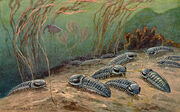
Illustration of some trilobites by Heinrich Harder.

Illustration of a sea scorpion by Aaron John Gregory.
- Trilobites (Early Cambrian-Late Permian): In 1967, Ralph Buchsbaum, Professor of Zoology at the University of Pittsburgh, told Mackal that he had taken photographs of fresh tracks identical to those of the fossil trilobite Cruziana. Buchsbaum intended to trap whatever animal had made the tracks, but lost his funding, and the mystery animal was never identified. In the 1870's, the crew of the famous HMS Challenger also hoped that they would be able to dredge up living trilobites from the ocean floor.[1] In 2004, Doctor Ron O'Dor, chief scientist of the multi-nation Census of Marine Life, also "speculated that Arctic waters might hide creatures known only from fossils, such as trilobites that flourished 300 million years ago".[2]
- Anomalocarid (Cambrian-Early Devonian): A surviving anomalocarid was one identity suggested for the Beast of Brunei, but the theory is dubious given the anomalocarids' absence from the fossil record since the Early Devonian. However, Shuker does not entirely rule out the remote possibility of anomalocarids surviving to the present day, since the most recent anomalocarid, Schinderhannes, is a full 100 million years younger than the next most recent.[3]
- Eurypterid (sea scorpion; Mid Ordovician-Late Permian): A boat-sized "sea scorpion" called kajanok agdlinartok supposedly resides in Greenland's Lake Natsilik. Eberhart lists a descendant of a sea scorpion such as Pterygotus as a possible identity for the cuero of Argentin and Chile.[4] Heuvelmans also considered and rejected a sea scorpion identity for the many-finned sea serpent type. Shuker agrees with his rejection, and considers the existence of post-Permian sea scorpions unlikely, given the lack of evidence.[5]
Reptilia[]
Crocodilians[]
- Mekosuchus (Oligocene-Holocene): David Alderton speculated that a descendant of this mekosuchine, or a descendant of a relative, could still survive on the countless unexplored islands near New Caledonia.[6]
Mammalia[]
Multituberculates and other primitive mammals[]
- Pantodont (Paleocene-Eocene): Xu lists a living pantodont, a very early large non-placental mammal, as a possible identity for the hezhugong, which is said to resemble a hippopotamus.[7]
- Uintatherium (Eocene): Xu lists a living uintathere as a possible guancaishou identity.[7]
Marsupials[]

Illustration of Diprotodon by an unknown artist.

Reconstruction of Palorchestes by artist Peter Schouten.

The thylacine is perhaps the most famous of putative prehistoric survivors.
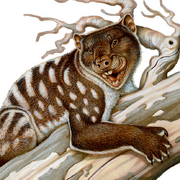
Illustration of the marsupial lion (Thylacoleo carnifex) by H. Kyoht Luterman.
- Diprotodon (Pleistocene): Aboriginals claimed that the bones of Diprotodon belonged to the gyedarra, an animal which died out only a couple of generations ago: The animals, which were the size of a draught horse, lived in water-filled holes in riverbanks and came out only to feed.[5] C. W. Anderson and Shuker suggest that the bunyip is based on memories of Diprotodon, which is not known to have been aquatic.[4] Diprotodon was suggested as an identity for the "giant rabbits" seen by prospectors in the Australian interior,[8] but this is regarded as improbable.[8]
- Hulitherium (Pleistocene): Cryptozoologists including Shuker speculate that the yowie could be explained by a living relative of Hulitherium, a giant diprotodontid which appears to have been bipedal.[8]
- Giant kangaroo: Janis suggests that the "giant rabbits" seen by prospectors in the Australian interior could have been giant sthenurine kangaroos, which may have had shorter tails, bigger forearms, and longer ears than modern kangaroos.[8]
- Nototherium (Pliocene-Pleistocene): Nototherium is listed by Eberhart as a possible identity for the gazeka.[4]
- Palorchestes (Miocene-Pleistocene): Janis and Shuker, eventually supported by Heuvelmans, suggest that the gazeka of New Guinea, which is said to have an elongated snout, could have been a living Palorchestes. Palorchestes was suggested as an identity for the "giant rabbits" seen by prospectors in the Australian interior,[8] but this is regarded as improbable.[8] Tim Flannery and Michael Archer suggest that the bunyip is based on memories of Palorchestes, which is not known to have been aquatic.[4]
- Thylacine: See article.
- Thylacoleo (marsupial lion; Late Pliocene-Late Pleistocene): The Queensland tiger is widely speculated to be a living Thylacoleo or relative, as this animal fits the cryptid's physical, behavioural, and ecological profile almost exactly. Another cat-like marsupial predator, the warrigal of New South Wales, may be a second living species, and some Australian big cat sighting could be explained by melanistic marsupial lions.[5]
- Thylacosmilus (Late Miocene-Pliocene): Heuvelmans felt that the striped, fanged cats reported from Ecuador and Colombia were more likely to be descendants of Thylacosmilus than living sabre-toothed cats.[9]
Pholidota[]
- Manis paleojavanica (Asian giant pangolin; Late Pleistocene): Mareš theorised that the veo, an enormous cryptid of Rintja (Indonesia) highly reminiscent of a pangolin, could be a living version of Manis paleojavanica, a giant pangolin which lived on Java and Borneo. Pangolins are not known from Rintja, so it is interesting that the locals perfectly describe a giant pangolin in the veo.[10][11]
Xenarthrans[]

Illustration of the giant ground sloth Megatherium by Michael Long.

Illustration of the Puerto Rican sloth (Acratocnus odontrigonus), depicted without the long tail characteristic of ground sloths, by the American Museum of Natural History.

Reconstruction of Thalassocnus by Velizar Simeonovski.
- Glyptodont: (Early Miocene-Late Pleistocene): Enormous armadillos are reported from Brazil (tatu-aruiap)[12] and Venezuela.[13] Jorge Claraz, Francisco Moreno, and Whittall all believe(d) that the Chilean ellengassen, a man-like animal with a large shell, may have been a late-surviving glyptodont.[14] Heuvelmans originally theorised that the Minhocão could be a fossorial, semi-aquatic glyptodont,[9] but Shuker criticises this theory on account of a glyptodon's bulk, which would make it unlikely to be a burrower,[8] although Drinnon notes that burrowing gopher tortoises also have domed shells.[12] Possible depictions of glyptodonts also exist in pre-Columbian artefacts. A report of a possible glyptodont captured in South America, which was investigated by Sanderson in the 1960's or 1970's, turned out to be a hoax.[5]
- Pampathere (Late Oligocene-Late Pleistocene): Given the above-mentioned criticisms of the minhocão-glyptodont theory, an alternative suggestion regarding this cryptid is that it could have been a surviving pampathere. Pampatheres were rather more elongate than glyptodonts, and were more flexible due to banded shells.[4]
- Ground sloths (Late Eocene-Mid Holocene):
- Giant ground sloths:
- In South America: Most cryptid ground sloths are medium-sized, comparable to bears, and are usually speculated to be mylodontids or megalonychids. However, a 1980's report from Ecuador described a ground sloth which was ten feet long and alleged to be the giant ground sloth, Megatherium americanum, itself;[4] and a sloth reported from the Orinoco basin is reputedly sixteen feet long.[13]
- In Central America: Sanderson believed that the hairy lizard-shaped "cave cows" reported from Belize could be medium-sized ground sloths. Thomas Gann claimed to have seen a shaggy animal with a white mane which he thought looked like a ground sloth during an expedition to the Río Azul, Quintana Roo State, Mexico,[5] but this may have been a spectacled bear very far north of its known range.
- In North America: Ground sloths have also been reported from North America, sometimes explicitly identified by eyewitnesses. Besides the cryptids which are specifically described as sloths, some researchers theorise that the sheepsquatch and some Bigfoot sightings could be explained by surviving ground sloths, and it is speculated that the Canadian saytoechin could be a giant sloth.
- In Oceania: A handful of dubious reports of ground sloths have originated in Australia and New Zealand. Author Gavin Menzies claimed that a Mylodon had been captured by a Chinese voyage which made it to the New World before Europeans, and which was subsequently wrecked off New Zealand, allowing the sloths to breed there, eventually being observed by sailors. However, Shuker investigated the claim and discovered that the original story described some sort of enormous kangaroo.[15] Two Australian users on 4chan's /x/ board also independently claimed to have encountered large, bear-like animals which they identified as ground sloths, though if they were real they may have been diprotodonts.
- Small ground sloths: "Little people" of the Caribbean, including yehos, small ape-like animals with claws, have been suggested to represent living forms of smaller, arboreal West Indian ground sloths, which seem to have persisted until at least the European discovery of the New World.[12] Missionary Thomas Bridges also originally believed the saapaim, a shaggy sheep-sized animal with large claws reported from the deepest forests of Tierra del Fuego in Chile, could have been "a sloth".
- Aquatic ground sloths (Late Miocene-Late Pliocene): Whittall speculates that a late-surviving (post-Ice Age) freshwater Patagonian species of the bulky, aquatic Thalassocnus could explain several Patagonian lake monsters.[16] (A freshwater ground sloth, Ahytherium, is known from Brazil.)
- Giant ground sloths:
Notoungulates and other meridiungulates[]

Reconstruction of Toxodon by artist Velizar Simeonovski.
- Astrapothere (Late Eocene-Mid Miocene): An astrapothere was suggested to be the subject of a pre-Columbian pottery figure of an elephant-like animal discovered at Tiahuanaco, but was rejected by Shuker.[17]
- Litoptern (Palaoecene-Late Pleistocene): Pottery fragments showing llama-like animals with five toes were discovered in the pre-Incan Paracas culture area near Pisco in the 1920's, alongside unidentified bones apparently belonging to the animal depicted. Llamas have only two toes, leading to speculation that the animal could have been a surviving litoptern such as Macrauchenia, which had three toes.[4]
- Pyrothere (Mid Eocene-Early Oligocene): A pyrothere was suggested to be the subject of a pre-Columbian pottery figure of an elephant-like animal discovered at Tiahuanaco, but was rejected by Shuker.[17]
- Toxodont (Late Oligocene-Mid Holocene): Drinnon suggests that water bulls may be living toxodonts, and that three-toed tracks sometimes discovered in Bolivia, Brazil, Colombia, and Peru and often ascribed to living dinosaurs are actually the tracks of living toxodonts, which were three-toed.[12] Ceramic pottery and stonework discovered at a Tiahuanacan city near Pisco may depict a toxodont. Sir Ray Lankester told Arthur Conan Doyle that toxodonts might still survive in South America, leading to its inclusion in The Lost World.[5]
- Homalodotherium (Early-Mid Miocene): Discussing the case of Domenech's pseudo-goat, a goat-shaped animal with claws and horns reported from North America, Eberhart notes that Homalodotherium, a clawed ungulate of Argentina, is its closest match in the fossil record.[4]
- Trigodon (Late Miocene-Pliocene): 9,000 year old cave paintings at Lake Posadas may depict a "unicorn" very similar to the one-horned Trigodon, supposedly extinct for two million years.[18]
Rodents[]
Size comparision of Castoroides and a human, from prehistoric-wildlife.com.
- Castoroides (giant beaver; Late Pliocene-Early Holocene): The giant beaver has been proposed as the reality behind Native American myths of monstrous beavers.[4] Modern sightings of huge, sometimes horse-sized beavers have also occurred in North America, and very large beaver-like tracks have been reported.[primary source needed]
Chiroptera[]
- Desmodus draculae (giant vampire bat; Pleistocene-Holocene): Based on reports of very large vampire bats attacking both cattle and men, it has been theorised that the giant vampire bat Desmodus draculae may still survive in Brazil.[4] Apparently unfossilised bones of Desmodus draculae have also been discovered.
Cetaceans[]
Primitive carnivores[]
Illustration of amphicyonids by Mauricio Anton.
- Amphicyonid (bear-dog; Middle Eocene-Late Pliocene): An amphicyonid is famous as a proposed identity for the waheela, though it has also been put fowards as an explanation for the shunka warak'in.[4] Xu also lists it as a possible lütoulang identity.[7]
- Hyaenodont (Late Palaeocene-Late Miocene): Xu lists a living hyaenodont as a possible lütoulang identity. Its boxy, donkey-like head and confirmed habit of preying on other big predators is consistent with the appearance and behaviour of the lütoulang.[7]
- Simbakubwa (Early Miocene): Fossils of Simbakubwa were discovered close to a region supposedly home to the Nandi bear, leading Shuker to ask whether a living descendant of this creodont should be added to the list of Nandi bear identities.[19]
- Mesonychid: It has been suggested that the Beast of Gevaudan could have been a living mesonychid, but this is regarded as unlikely by most cryptozoologists. Xu also lists it as a possible lütoulang identity.[7]
Carnivorans[]
Cats[]
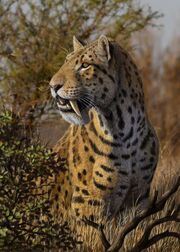
Reconstruction of the African sabre-toothed cat Megantereon whitei by Mauricio Antón.
Digital reconstruction of the American lion Panthera atrox or Panthera leo atrox by artist Sergiodlarosa.
- Sabre-toothed cat (Miocene-Early Holocene): Possible living sabre-toothed cats are reported from three continents. Notably, the sabre-tooted cat cryptids of South America and Africa appear to be a case of convergent evolution: sabre-toothed river animals and sabre-toothed mountain animals are reported from both continents. This makes sense, as there are only so many niches a predatory big cat can take.[5][20]
- In South & Central America: Smilodon (the only sabre-toothed cat known to have existed in South America) may be depicted on pre-Columbian pottery in Colombia. Striped cats with long fangs, slightly smaller than jaguars, are reported from the montane forests of Ecuador and Colombia, and are speculated to be a smaller, more specialised form of Smilodon: one was supposedly shot and examined in Paraguay in 1975. Another group of possible specialised sabre-toothed cats are the short-tailed, long-fanged water tigers, reported from Brazil, Ecuador, Guyana, and French Guiana, which are described as highly dangerous, river-dwelling, long-fanged predators.[5] A sabre-toothed cat was also allegedly seen in Mexico in 1994.[2]
- In Africa: Mountain-dwelling big cats with stripes, short tails, and fangs are reported from Chad, the Central African Republic, Sudan, South Sudan, and Mali.[4] Heuvelmans theorises that they inhabit the niche of an animal like the bear, and hide their prey in mountain caves to avoid scavengers. Water lions, the African answer to water tigers, are reported from several Central African nations, as well as Kenya; they are usually described as cat-like animals with long fangs and short tails, and Heuvelmans suggests they are sabre-toothed cats that took to the water to avoid competition with other predators, and to decompose their food in water, making it easier for them to eat. They are frequently alleged to have killed people. Heuvelmans theorised that a number of other large, dangerous African mystery cats could be sabre-toothed cats, which may not always have displayed their famous fangs.[20] A striped cat with long fangs which preys on lions, the wanjilanko, is also reported from Senegal.[4]
- In Asia: The guoshanhuang, a large cat with long fangs reported from China, is speculated to be a sabre-toothed cat, perhaps Dinofelis, though it is reputed to have a long tail.[7] Freeman theorised that the cigau of Indonesia could be a living Homotherium.[2]
- Panthera atrox or Panthera leo atrox (American lion; Pleistocene-Early Holocene): Coleman and Hall theorise that sightings of maned American lions and certain black panthers can be satisfactorily explained by living American lions with sexually dimorphic appearance and behaviour.[21]
- Panthera spelaea (cave lion; Mid Pleistocene-Early Holocene): Drinnon suggests that Tibetan snow lions and Chinese guardian lions represent living or late-surviving cave lions.[12] It has been suggested that the "buffalo lions" of Tsavo, including the famous man-eaters, may be living cave lions on account of their lack of manes and preference for larger prey.[4] Coleman suggests that the lions which attacked Xerxes army in Macedonia, and lions mentioned as living in Scotland in early Medieval times, were cave lions.[21]
Dogs[]
- Borophagine (Oligocene-Pliocene): One theory regarding the shunka warak'in is that it could be a surviving borophagine dog. Borophagine dogs were a diverse group which filled various niches in America, and are believed to have gone extinct when they were replaced by dogs.[4]
Bears[]
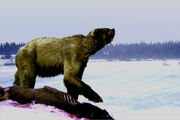
Illustration of Arctodus simus by an unknown artist.
- Agriotherium (Miocene-Pleistocene): As the only bear known to have ever lived in sub-Saharan Africa, Agriotherium is a Nandi bear suspect.[19]
- Arctodus (short-faced bear; Mid Pleistocene-Early Holocene): C. Hart Merriam, who examined the body of MacFarlane's bear, thought its dentition resembled that of Arctodus more than a brown bear. Russian zoologist Nikolai K. Vereshchagin wrote that the irkuiem of Kamchatka could be a short-faced bear, which are not known from Russia but could have crossed the Bering Land Bridge (in fact, the irkuiem is said to have arrived in Kamchatka from across the Chukchi Sea, floating on Alaskan ice).[5][12] Large bears with cat-like faces and the limb proportions of gorillas have been reported from the United States, but are often listed as Bigfoot sightings. The high plains of America were once inhabited by a giant "grizzly bear" which preyed on bison, and a "bulldog bear" capable of carrying off a moose was reported from much of Canada.[12] A short-faced bear is also one identity listed for the saytoechin.[22]
- Arctotherium (South American short-faced bear; Early Pleistocene-Early Holocene): The milne, an enormous black bear reported from the Amazon, could be explained as a living Arctotherium.[12] Giant bear tracks were discovered in the Patagonian Andes at least twice in the late Nineteenth Century.[23]
Hyenas and miscellaneous carnivorans[]
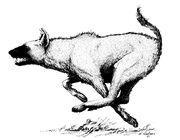
Chasmaporthetes, the running hyena, drawn by Henry Galiano.

A model of Pachycrocuta at the Hungarian Natural History Museum, photographed by Wikipedia user Tiberio.
- Chasmaporthetes (Pliocene-Early Holocene): Chasmaporthetes, the only known American hyaenid, has been suggested as an identity for the American hyena and the shunka warak'in, which appear to be hyenas of some sort. Michael Swords also suggests that a surviving Chasmaporthetes (which is also known from North Africa) could have inspired the Ancient Egyptian god Set.[4] Xu lists it as a possible lütoulang identity (it is also known from China).[7]
- Hyaena sinensis: This Chinese relative of the striped and brown hyenas is listed as a possible lütoulang identity by Xu.[7]
- Pachycrocuta (giant short-faced hyena; Late Pliocene-Mid Pleistocene): the giant hyena Pachycrocuta has been put forwards as an explanation for the Nandi bear and the Senegalese booa by Shuker.[5][4] Xu also lists Pachycrocuta as one of the many possible identities of the lütoulang.[7]
Ungulates[]
Even-toed[]
Model of Sivatherium at the Museum of Evolution of Polish Academy of Sciences, photographed by Wikipedia user Hiuppo.
- Anthracotherium (Early Eocene-Early Miocene): Xu lists a living Anthracotherium, an Asian relative of the hippopotamus, as a possible identity for the hezhugong, which was said to superficially resemble a hippopotamus.[7]
- Hexaprotodon (Miocene): Xu lists a living Hexaprotodon, an Asian pygmy hippopotamus which may be synonymous with the modern African pygmy hippopotamus, as a possible identity for the hezhugong, which was said to superficially resemble a hippopotamus.[7]
- Prehistoric giraffids (Pliocene-Early Holocene)
- Bramatherium (Late Miocene-Pliocene): Janis suggested that certain Eurasian artefacts may depict Bramatherium.[24]
- Sivatherium (Pliocene-Early Holocene): A number of artefacts which may depict sivatheres have been discovered across North Africa and the Near East. It has also been suggested that the Chinese qilin, the sirrush of the Ishtar Gate, and the head of the god Set may have been inspired by sivatheres.[4] Drinnon suggests that the "living dinosaurs" ngoubou and ninki-nanka could be living sivatheres, noting that the ngoubou is said to give live birth and have an elephant-like tail, and theorising that its supposed beak could be a drooping upper lip. There is also a mid-Victorian print depicting a sivathere-like animal drawn by illustrator Charles Laplante: its origin, and whether it depicts a real or a fictional scene, is unknown.[12] Heuvelmans suggested that a "deer" reported from Ethiopia could be a Libytherium,[9] but Janis regards it as a possible Ethiopian fallow deer.[8]
- Tsaidamotherium (Early Miocene-Late Miocene): Drinnon believes that the Tibetan unicorn and the Chinese qilin could be based on the Miocene captine Tsaidamotherium, which they closely resemble.[12]
Odd-toed[]
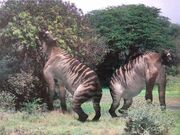
Ancylotherium, the latest known African chalicothere, as depicted in the BBC TV series Walking with Beasts.

Illustration of Elasmotherium by Zdenek Burian.
- Chalicothere (Mid Eocene-Early Pleistocene): Chalicotheres may be depicted on a pair of belt plaques found in a Saka tomb in Siberia: the plaques show a horse-like animal with clawed feet.[24] Drinnon suggests that griffins are based on chalicotheres, which may have had overhanging lips: according to Drinnon, the griffin's original defining features were its claws, not its wings.[12] A chalicothere is most famously regarded as a possible Nandi bear identity, a theory which has caused some considerable discussion among mainstream zoologists as well as cryptozoologists.[5] Captain Hichens also suggested that the chipekwe could be a chalicothere, though it does not fit the description at all.[4] Heuvelmans negatively discussed the dubious idea that the water lion dilali, described as a clawed horse, could have been a chalicothere.[25] A living chalicothere has also been suggested as an identity for various Chinese cryptids, including the mo, certain wildmen, and, more implausibly, the lütoulang.[7]
- Chilotherium (Late Miocene-Pliocene): Xu suggests that the rhinoceros-like shanlü, which was said to have a pair of horns on its forehead, could be a living Chilotherium. Chilotherium did not have horns, but it did have a pair of large tusk-like incisors which could be mistaken for horns.[7]
- Elasmotherium (Late Pliocene-Late Pleistocene): With its singe long horn, Elasmotherium is widely regarded as a possible inspiration for stories of unicorns, especially the more powerfull "black bull" unicorns of Central Asia.[5] Drinnon notes that, if Elasmotherium lived on the Asiatic steppe in modern times, "it would only rarely live in the actual desert regions, but in the early post-glacial the deserts were much less extensive. Later populations would have drawn into cluster areas south of Lake Baikhal and in Persia and the northern Fertile Crescent; those are areas where we find the stories about them persisting later.".[12]
- Teleoceras (Early Miocene-Early Pliocene): A living Teleoceras is listed as a possible guancaishou identity by Xu, though he admits that this animal is not known from China.[7]
Afrotheres[]
Proboscideans[]

Illustration of the early probiscidean Moeritherium by Heinrich Harder. Note that Moeritherium is not believed to have had tusks.

Arsinoitherium as drawn by Zdeněk Burian.
- Arsinoitherium (Eocene-Oligocene): Mackal and Shuker note that the emela-ntouka somewhat resembles Arsinoitherium, which is known to have lived in North Africa, and was aquatic. However, Arsinoitherium had two horns, whilst the emela-ntouka has two: it also lacks a long, heavy tail.[26][27]
- Deinotherium (Late Oligocene-Pleistocene): M. Le Petit and Emile Gromier suggested that the Rothschild tusk could have come from a living deinothere, but its discoverers had already discounted this possibility on account of the tusks small size. Nevertheless, Le Petit and Gromier planned to lead an expedition to Lake Chad in search of living deinotheres; unusual but obscure elephant-like creatures with downwards-curved tusks had been reported from several East African lakes.[28][29]
- Moeritherium (Late Eocene): Shuker notes that a descendant of an early proboscidean such as Moeritherium would bear a striking resemblance to the squat, tuskless, short-trunked, small-eared water elephant of the Congo.[5]
- Phiomia (Late Eocene-Early Oligocene): Shuker notes that a descendant of an early proboscidean such as Phiomia would bear a striking resemblance to the squat, tuskless, short-trunked, small-eared water elephant of the Congo.[5]
Others[]
- Steller's sea cow (Pleistocene-Late Holocene): See article.
Primates[]
Lemurs[]
Monkeys[]
- Giant baboon: A giant baboon such as Theropithecus oswaldi (Pleistocene) or Dinopithecus (Pleistocene) has been suggested as an explanation for the more ape-like version of the Nandi bear.[25] A troop of baboons almost five feet at the shoulder were also observed during a 1980 expedition to Kenya's Mount Suswa.[29] The "South African Bigfoot," waterbobbejan, is also sometimes described as an enormous baboon. Hall suggested that devil monkeys could be living examples of Theropithecus oswaldi, which is, however, not known from the Americas.[4]
Great apes (not inc. hominoids)[]
Hominoids[]
Cryptozoologists referenced[]
For the sake of simplicity, cryptozoologists in the list are only mentioned by surname; for sourcing purposes, their full names can be found here.
- Loren Coleman
- Philippe Coudray
- Dale A. Drinnon
- George Eberhart
- Richard Freeman
- Mark A. Hall
- Bernard Heuvelmans
- Christine Janis
- Roy P. Mackal
- Jaroslav Mareš
- Ivan T. Sanderson
- Karl Shuker
- David C. Xu
References[]
- ↑ Mackal, Roy P. (1980) Searching for Hidden Animals: An Inquiry Into Zoological Mysteries, Cadogan Books, ISBN 978-0946313051
- ↑ 2.0 2.1 2.2 Shuker, Karl P. N. (2010) Karl Shuker's Alien Zoo: From the Pages of Fortean Times, CFZ Press, ISBN 978-1-905723-62-1
- ↑ Shuker, Karl P. N. ShukerNature: TRILOBITE BEETLES, CETI EELS, AND THE BEAST OF BRUNEI karlshuker.blogspot.com [Accessed 29 May 2019]
- ↑ 4.00 4.01 4.02 4.03 4.04 4.05 4.06 4.07 4.08 4.09 4.10 4.11 4.12 4.13 4.14 4.15 4.16 4.17 4.18 4.19 Eberhart, George M. (2002) Mysterious Creatures: A Guide to Cryptozoology ABC-CLIO, Inc. ISBN 1-57607-283-5
- ↑ 5.00 5.01 5.02 5.03 5.04 5.05 5.06 5.07 5.08 5.09 5.10 5.11 5.12 5.13 Shuker, Karl P. N. (1995) In Search of Prehistoric Survivors: Do Giant 'Extinct' Creatures Still Exist?, Blandford, ISBN 9-780713-724691
- ↑ Alderton, David (2003) Crocodiles and Alligators of the World, Facts on File Inc., ISBN 978-0816057146
- ↑ 7.00 7.01 7.02 7.03 7.04 7.05 7.06 7.07 7.08 7.09 7.10 7.11 7.12 7.13 Xu, David C. (2018) Mystery Creatures of China: The Complete Cryptozoological Guide, Coachwhip Publications, ISBN 978-1616464301
- ↑ 8.0 8.1 8.2 8.3 8.4 8.5 8.6 8.7 Shuker, Karl P. N. "A Supplement to Dr Bernard Heuvelmans' Checklist of Cryptozoological Animals," Fortean Studies 5 (1998)
- ↑ 9.0 9.1 9.2 Heuvelmans, Bernard "Annotated Checklist of Apparently Unknown Animals With Which Cryptozoology Is Concerned", Cryptozoology 5 (1986)
- ↑ Mares, Jaroslav (1997) Svet tajemnych zvírat
- ↑ Shuker, Karl "A Scaly Tale from Rintja", Fortean Times 116 (November 1998)
- ↑ 12.00 12.01 12.02 12.03 12.04 12.05 12.06 12.07 12.08 12.09 12.10 12.11 Drinnon, Dale A. (2009) "Amended Cryptozoological Checklist"
- ↑ 13.0 13.1 Vašíček, Arnošt (1996) Planeta Záhad
- ↑ Whittall, Austin Mapinguari the Amazonian Mylodon | Patagonian Monsters patagoniamonsters.blogspot.com [Accessed 7 February 2019]
- ↑ Shuker, Karl P. N. ShukerNature: THE YUKON BEAVER EATER, AND GROUND SLOTHS IN NEW ZEALAND? karlshuker.blogspot.com [Accessed 28 May 2019]
- ↑ Whittall, Austin Marine Ground Sloths | Patagonian Monsters patagoniamonsters.blogspot.com [Accessed 28 May 2019]
- ↑ 17.0 17.1 Shuker, Karl P. N. ShukerNature: FIRE BEASTS, LIGHTNING BEASTS, AND THE ELEPHANT OF TIAHUANACO - INVESTIGATING AN ANOMALOUS ARCHAEOLOGICAL ARTEFACT FROM SOUTH AMERICA karlshuker.blogspot.com [Accessed 29 May 2019]
- ↑ Whittall, Austin The Patagonian Unicorns - Part 1 | Patagonian Monsters patagoniamonsters.blogspot.com [Accessed 29 December 2018]
- ↑ 19.0 19.1 Shuker, Karl "A Fossil Nandi Bear?," Fortean Times 380 (June 2019)
- ↑ 20.0 20.1 Heuvelmans, Bernard & Rivera, Jean-Luc & Barloy, Jean-Jacques (2007) Les Félins Encore Inconnus d’Afrique, Les Editions de l'Oeil du Sphinx, ISBN 978-2914405430
- ↑ 21.0 21.1 Coleman, Loren (2000) Mysterious America: The Revised Edition, Paraview Press, ISBN 978-1931044059
- ↑ LeBlond, Paul "Yukon Cryptids", British Columbia Scientific Club Newsletter 14 (April 1993)
- ↑ Whittall, Austin Bears in Patagonia | Patagonian Monsters patagoniamonsters.blogspot.com [Accessed 28 May 2019]
- ↑ 24.0 24.1 Janis, Christine "Fossil Ungulate Mammals Depicted on Archaeological Artifacts," Cryptozoology 6 (1987)
- ↑ 25.0 25.1 Heuvelmans, Bernard (1955) On the Track of Unknown Animals, Routledge, ISBN 978-1138977525
- ↑ Mackal, Roy P. (1987) A Living Dinosaur? In Search of Mokele-Mbembe, Brill, ISBN 978-9004085435
- ↑ Shuker, Karl P. N. ShukerNature: THE EMELA-NTOUKA – NEW CORROBORATIVE EVIDENCE FOR THE CONGO'S CRYPTIC 'KILLER OF ELEPHANTS'? karlshuker.blogspot.com [Accessed 28 May 2019]
- ↑ Shuker, Karl P. N. ShukerNature: THE CURIOUS CASE OF ROTHSCHILD'S LOST TUSK AND THE NON-EXISTENT ELEPHANT PIG - AN ENDURING CRYPTOZOOLOGICAL CONUNDRUM FROM AFRICA karlshuker.blogspot.com [Accessed 28 May 2019]
- ↑ 29.0 29.1 Coudray, Philippe (2009) Guide des Animaux Cachés, Editions du Mont, ISBN 978-2915652383
